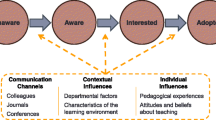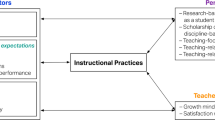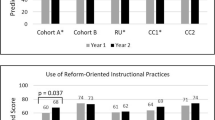Abstract
A growing body of research suggests that student-centered teaching methods are associated with positive learning outcomes for undergraduate students. Yet, the extent of their use and factors leading to their adoption in fields, such as chemistry, continue to be under-explored. Utilizing survey data collected during 2015, we begin to fill this gap, first by considering the degree to which faculty and instructors use and plan to use various student-centered teaching methods in their undergraduate chemistry courses. Then, we examine three potential factors that may help us understand variation in (1) use of and (2) intentions to implement student-centered methods: attitudes toward teaching methods; teaching approaches; and institutional characteristics. Importantly, our findings suggest attitudes and individual teaching approaches are significant predictors of the use and intention to implement student-centered methods in the classroom. Perhaps surprisingly, several institutional factors examined (such as class size, percentage of time spent teaching, and type of institution) play no significant role. Given the positive student outcomes associated with various student-centered methods reported in literature, these findings suggest potential avenues for faculty and instructors’ professional development toward further implementation of these methods.

Similar content being viewed by others
References
Ajzen, I., & Fishbein, M. (1973). Attitudinal and normative variables as predictors of specific behavior. Journal of Personality and Social Psychology, 27, 41–57.
Albanese, M. A., & Mitchell, S. (1993). Problem-based learning—a review of literature on its outcomes and implementation issues. Academic Medicine, 68, 52–81.
Allport, G. W. (1935). In C. Murchison (Ed.), Attitudes. Handbook of social psychology. Worcester, MA: Clark University Press.
Bandyopadhyay, S., & Rathod, B. B. (2017). The sound and feel of titrations: a smartphone aid for color-blind and visually impaired students. Journal of Chemical Education, 94, 946–949.
Basili, J. C., & Sanford, P. J. (1991). Conceptual change strategies and cooperative group work in chemistry. Journal of Research in Science Teaching, 28, 293–304.
Briggs, M., Long, G., & Owens, K. (2011). Qualitative assessment of inquiry-based teaching methods. Journal of Chemical Education, 88, 1034–1040.
Dancy, M., & Henderson, C. (2010). Pedagogical practices and instructional change of physics faculty. American Journal of Physics, 78, 1056–1063.
Duncan, D. (2005). Clickers in the classroom: how to enhance science teaching using classroom response systems. San Francisco, CA: Pearson/Addison Wesley.
Farrell, J. J., Moog, R. S., & Spencer, J. N. (1999). A guided-inquiry general chemistry course. Journal of Chemical Education, 75, 570–573.
Felder, R. M., & Brent, R. (1996). Navigating the bumpy road to student-centered instruction. College Teaching, 44(2), 43–47.
Freeman, S., Eddy, S. L., McDonough, M., Smith, M. K., Okoroafor, N., Jordt, H., & Wenderoth, M. P. (2014). Active learning increases student performance in science, engineering, and mathematics. Proceedings of the National Academy of Sciences, 111(23), 8410–8415.
Handelsman, J., Ebert-May, D., Beichner, R., Bruns, P., Chang, A., DeHaan, R., Gentile, J., Lauffer, S., Stewart, J., Tilghman, S. M., & Wood, W. B. (2004). Scientific teaching. Science, 304, 521–522.
Hattie, J., & Marsh, H. W. (1996). The relationship between research and teaching—a meta-analysis. Review of Educational Research, 66, 507–542.
Hein, S. M. (2012). Positive impacts using POGIL in organic chemistry. Journal of Chemical Education, 89, 860–864.
Henderson, C., & Dancy, M. H. (2007). Barriers to the use of research-based instructional strategies: the influence of both individual and situational characteristics. Physical Review Special Topics–Physics Education Research, 3(020102), 1–14.
Henderson, C., & Dancy, M. H. (2009). Impact of physics education research on the teaching of introductory quantitative physics in the United States. Physical Review Special Topics–Physics Education Research, 5(020107), 1–9.
Henderson, C., Dancy, M., & Niewiadomska-Bugaj, M. (2012). Use of research-based instructional strategies in introductory physics: where do faculty leave the innovation-decision process? Physical Review Special Topics–Physics Education Research, 8(020104), 1–15.
Jansson, S., Soderstrom, H., Andersson, P. L., & Nording, M. L. (2015). Implementation of problem-based learning in environmental chemistry. Journal of Chemical Education, 92, 2080–2086.
Korich, A. L. (2016). Harnessing a mobile social media app to reinforce course content. Journal of Chemical Education, 93, 1134–1136.
Lage, M. J., Platt, G. J., & Treglia, M. (2000). Inverting the classroom: a gateway to creating an inclusive learning environment. Journal of Economic Education, 31, 30–43.
Lom, B. (2012). Classroom activities: simple strategies to incorporate student-centered activities within undergraduate science lectures. The Journal of Undergraduate Neuroscience Education, 11, A64–A71.
Lorenzo, M., Crouch, C. H., & Mazur, E. (2006). Reducing the gender gap in the physics classroom. American Journal of Physics, 74, 118–122.
Lyman, F. T., Jr. (1981). The development of tools. Maryland A.T.E. Journal, 1, 20–21.
Morsch, L. A., & Lewis, M. (2015). Engaging organic chemistry students using ChemDraw for iPad. Journal of Chemical Education, 92, 1402–1405.
National Center for Education Statistics. (2016). College Navigator. http://nces.ed.gov/collegenavigator/. Accessed 16 June 2016.
Nichols, J., & Miller, R. (1994). Cooperative learning and student motivation. Contemporary Educational Psychology, 19, 167–178.
Osgood, C. E., Suci, G. C., & Tannenbaum, P. M. (1957). The measurement of meaning. Urbana, IL: University of Illinois Press.
Paulson, D. R. (1999). Active learning and cooperative learning in the organic chemistry lecture class. Journal of Chemical Education, 76, 1136–1140.
Pollock, S. J., & Finkelstein, N. D. (2008). Sustaining educational reforms in introductory physics. Physical Review Special Topics–Physics Education Research, 4(010110), 1–8.
Reder, M. (2007). Does your college really support teaching and learning? peerReview, 9, 9–13.
Ryan, M. D., & Reid, S. A. (2016). Impact of the flipped classroom on student performance and retention: a parallel controlled study in general chemistry. Journal of Chemical Education, 93, 13–23.
Seymour, E. (2001). Tracking the process of change in US undergraduate education in science, mathematics, engineering, and technology. Science Education, 86, 79–105.
Snyder, T. D., de Brey, C., & Dillow, S. A. (2016). Digest of Education Statistics 2014 (NCES 2016–006). Washington, DC: National Center for Education Statistics, Institute of Education Sciences, U.S. Department of Education.
Spencer, J. (1999). New directions in teaching chemistry: a philosophical and pedagogical basis. Journal of Chemical Education, 76, 566–569.
Stes, A., Gijbels, D., & Van Petegem, P. (2008). Student-focused approaches to teaching in relation to context and teacher characteristics. Higher Education, 55, 255–267.
Student-Centered Learning. (2014). Retrieved from http://edglossary.org/student-centered-learning/. Accessed 10 Dec 2017.
The Carnegie Classification of Institutions of Higher Education. (2016). Indiana University School of Education. http://carnegieclassifications.iu.edu/index.php. Accessed 16 June 2016.
Trigwell, K. (2002). Approaches to teaching design subjects: a quantitative analysis. Art, Design, & Communication in Higher Education, 1, 69–80.
Trigwell, K., & Prosser, M. (1996). Congruence between intention and strategy in university science teachers’ approaches to teaching. Higher Education, 32, 77–87.
Trigwell, K., & Prosser, M. (2004). Development and use of the approaches to teaching inventory. Educational Psychology Review, 16, 409–424.
Vital, F. (2012). Creating a positive learning environment with the use of clickers in a high school chemistry classroom. Journal of Chemical Education, 89, 470–473.
Walczyk, J. J., & Ramsey, L. L. (2003). Use of learner-centered instruction in college science and mathematics classrooms. Journal of Research in Science Teaching, 40, 566–584.
Acknowledgments
The study herein was approved by the Institutional Review Board (IRB) at The Ohio State University. We thank Mickey Rogers for assisting in data collection as well as all of the participants for volunteering their time in completing our survey.
Supporting Information
Correlation Table, Alternative Regression Models Predicting Number of Student-Centered Methods Used; Alternative Regression Models Predicting Number of Student-Centered Methods Intended to Implement
Funding
Funding for this project was provided through the College of Arts & Sciences at The Ohio State University in Columbus.
Author information
Authors and Affiliations
Corresponding author
Ethics declarations
Conflict of Interest
The authors declare that they have no competing financial interest.
Additional information
Publisher’s Note
Springer Nature remains neutral with regard to jurisdictional claims in published maps and institutional affiliations.
Rights and permissions
About this article
Cite this article
Yoder, R.J., Bobbitt-Zeher, D. & Sawicki, V. Understanding the Use of Student-Centered Teaching Methods in Undergraduate Chemistry Courses. Res Sci Educ 51 (Suppl 2), 845–863 (2021). https://doi.org/10.1007/s11165-019-9820-5
Published:
Issue Date:
DOI: https://doi.org/10.1007/s11165-019-9820-5




